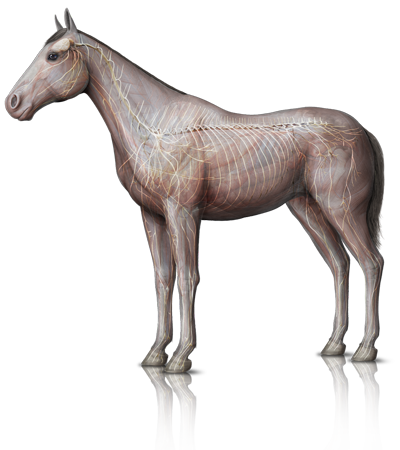
The neurological system represents one of the communication mechanisms in the horse’s body. The nervous system includes the brain, spinal cord, and branching nerves that conduct signals throughout the entire body.
Anatomically, the nervous system consists of two main areas: central, the brain and spinal cord; and peripheral, the nerves coming from the brain and spinal cord to innervate areas of the body. The control of the nervous system falls into two separate categories: the somatic and autonomic nervous systems. The somatic nervous system relays voluntary (conscious) signals to activate skeletal muscle movement to allow your horse to navigate its surroundings. In contrast, the autonomic nervous system relays involuntary (unconscious) signals to regions of the body to control your horse’s internal organs, such as the lungs, heart, and intestinal tract.
Indications that your horse may have a neurologic problem include: asymmetry of a body part, changes in gait, seizures, weakness, inability to rise/walk, incontinence, sudden blindness, behavior changes, and pain.
Common conditions affecting the equine nervous system include :
- Congenital abnormalities: Cervical Vertebral Malformations, Hydrocephalus
- Degenerative causes: Equine Degenerative Myeloencephalopathy (EDM), Cauda Equine Syndrome
- Infectious causes: Equine Protozoal Myeloencephalitis (EPM); Equine Herpesvirus (EHV); Rabies Virus; Verminous Encephalitis; West Nile Virus; Eastern, Western, and Venezualan Equine Encephalitis; Tetanus; Bacterial Meningitis; Inflammatory: Cervical Stenotic Myelopathy
- Metabolic: Hyperkalemic Periodic Paralysis, Hepatic Encephalopathy, Kidney Failure
- Nutrition: Selenium deficiency
- Toxins: Botulism, Tick Paralysis, Sorghum grass, Moldy Corn Disease, Locoweed, Yellow Star Thistle, Snake Bites
- Trauma to spinal cord and nerves
Brain

The horse’s brain, weighing just over a pound, contains hundreds of millions of nerve connections to control and coordinate specific functions in the body. Nerves travel directly from the brain or down the spinal cord to transmit signals back and forth to the rest of the body. The skull provides protection for this delicate organ. Problems within the brain manifest in a variety of ways depending on the region of the brain affected. Behavior changes, mental dullness, incoordination, and seizures are some common indications of brain disease.
Cervical Spine

As the skull protects the brain, the bony spine protects the spinal cord. The spinal cord passes through multiple vertebrae to provide a neurologic highway that connects the brain to the rest of the body. Muscles intimately attach to the spine and allow movement and activity. Disorders of the spinal column may involve the bony structures of the spinal column (e.g.: fractures, arthritis), the muscles that attach to it (e.g.: trauma), or the nerves that pass through (e.g.: Wobbler’s Syndrome). Symptoms of spinal injury include: pain along the spine, weakness, inability to walk or stand, and restlessness. Spinal injury requires immediate veterinary attention.
What's Next
Call us to schedule an appointment
Meet with a doctor for an initial exam.
Put a plan together for your pet.

